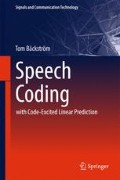Abstract
The objective of speech coding technologies is primarily to enable spoken communication between geographically separated people and also, to allow storage of speech signals. The performance of such technologies can be measured by both the perceived quality of the communication experience as well as the amount of resources required. For efficient performance, speech codecs are based on two types of modelling techniques applied in parallel: (1) they model the signal source by a model of speech production and (2) for optimisation of quality, they apply a perceptual model. These models include also entropy coding to remove statistical redundancy.
Access this chapter
Tax calculation will be finalised at checkout
Purchases are for personal use only
Notes
- 1.
Most authors do not define phonations so specifically, but let the term phonation refer to all physiological processes. Here it is, however, useful to use a similar definition for all three terms; phoneme, phonation and phone.
References
3GPP. TS 26.445, EVS Codec Detailed Algorithmic Description; 3GPP Technical Specification (Release 12) (2014)
ANSI. S3. 5-1997, Methods for the calculation of the speech intelligibility index (1997)
Bosi, M., Goldberg, R.E.: Introduction to Digital Audio Coding and Standards. Kluwer Academic Publishers, Dordrecht (2003)
Fastl, H., Zwicker, E.: Psychoacoustics: Facts and Models, vol. 22. Springer, Heidelberg (2006)
ISO/IEC 23003–3:2012. MPEG-D (MPEG audio technologies), Part 3: Unified speech and audio coding (2012)
Kates, J.M., Arehart, K.H.: Coherence and the speech intelligibility index. J. Acoust. Soc. Am. 117(4), 2224–2237 (2005)
Mäkinen, J., Bessette, B., Bruhn, S., Ojala, P., Salami, R., Taleb, A.: AMR-WB+: a new audio coding standard for 3rd generation mobile audio services. Proc. ICASSP 2, 1109–1112 (2005)
Author information
Authors and Affiliations
Corresponding author
Rights and permissions
Copyright information
© 2017 Springer International Publishing AG
About this chapter
Cite this chapter
Bäckström, T. (2017). Introduction. In: Speech Coding. Signals and Communication Technology. Springer, Cham. https://doi.org/10.1007/978-3-319-50204-5_1
Download citation
DOI: https://doi.org/10.1007/978-3-319-50204-5_1
Published:
Publisher Name: Springer, Cham
Print ISBN: 978-3-319-50202-1
Online ISBN: 978-3-319-50204-5
eBook Packages: EngineeringEngineering (R0)

